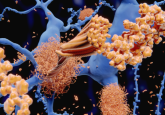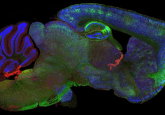Exploring new therapeutic targets and biomarkers for neurodegenerative disorders

 Shebna Massey (left) is an Associate Product Manager at Sino Biological whose expertise lie in drug discovery and cancer immunotherapy. Here she discusses neurodegenerative disorders, amyloid-β and searching for new drug targets.
Shebna Massey (left) is an Associate Product Manager at Sino Biological whose expertise lie in drug discovery and cancer immunotherapy. Here she discusses neurodegenerative disorders, amyloid-β and searching for new drug targets.
How much do we know about the etiology and pathogenesis of neurodegenerative diseases?
With increasing life expectancy, silently-progressive neurodegenerative disorders are becoming more prominent worldwide. The combinatorial effects of genetic aberrations, environmental factors, and age are mainly attributed to the onset of neurodegenerative disorders like Alzheimer’s disease (AD), Parkinson’s disease (PD), Huntington’s disease, and Amyotrophic lateral sclerosis.
The progressive loss of neurons, dysfunction of glial cells, and disruption in synaptic connections in the brain and spinal cord pathologically characterize these disorders. Some new paradigm-shifting etiological views propose cardiovascular diseases as the basis of homeostatic disruptions of various proteins affecting cognitive functioning. There are also studies highlighting the immunomodulatory functions of the gut-brain axis. An integrated and innovative approach is needed to incorporate these views into the traditional and classical etiological views and research of neurodegenerative disorders.
What are the common therapeutic targets in neurodegenerative disorders? What stages of development are they at?
Neurodegenerative disorders are distinguished based on the association of abnormally conformed toxic proteins, such as tauopathies, a-synucleinopathies, TDP-43 proteinopathies, and FUS/FET proteinopathies, where the associated proteins are Tau, a-synuclein, TDP-43, and FUS/FET, respectively. The aggregation of these abnormal proteins leads to the formation of tangles and plaques that cause neurodegeneration. One of the most popular neurodegenerative disorder associated-proteins is amyloid-beta, frequently detected as a co-accumulative protein with Tau in AD.
Amyloid and Tau proteins have been investigated to be established as therapeutic targets. Immunotherapy is the most advanced approach in the drug development stage for most of these targets. There are also vaccines and humanized antibodies targeting these disease associated-proteins. Experimental Alzheimer’s drugs targeting the tau protein have entered clinical trials this year. They will be in the study for the next ten years under the Dominantly Inherited Alzheimer Network Trials Unit trials. A promising antibody, gantenerumab, targeting amyloid, was also successful in a Phase 2/3 clinical trial under the same program. As amyloid plaques are associated with several neurodegenerative diseases, these successful treatments also bring hope for other similar conditions.
Many drugs that target amyloid-β in AD have failed to demonstrate clinical efficacy. Does this indicate the need for the discovery of novel targets? What’s the current progress on this?
Amyloid plaques were first reported in the 1800s in patients with dementia. Since then, the amyloid-b protein that promotes the formation of these plaques has been studied and observed as a critical step in pathogenesis in many neurodegenerative disorders, particularly AD. However, most treatments targeting Ab have not been clinically successful. This has sparked the idea in the field that these aggregation events might be preceded and, more importantly, dominated by other significant events that regulate this protein.
A recent study published in Scientific Reports has challenged the conventionally accepted sequence of events leading to plaque formation, where Ab is considered to initiate the domino effect of neurodegeneration. This study has instead linked autophagy dysfunction with the formation of amyloid plaques with strong in vivo evidence from five different mouse models. This will need further investigation to identify a pivotal target to validate and extend into clinical studies.
Co-aggregation with Ab makes Tau a preferred therapeutic target as well. Clinical trials on Tau as the target of antibodies or radiotracers in positron emission tomography (PET) make it a strong alternate candidate. Among all the clinical trials targeted toward AD, 40% are centered on Ab and 18% on Tau. Some small molecule inhibitors are being tested for targets in the areas of neuroprotection, neuroinflammation, growth factors, and neurometabolic and cardiovascular pathways, including molecules like IL-6, IFNGR1, p75NTR, APOE, GSK3b, ADRA2B, and CSF factors.
What models, tools, and research strategies are used for drug target discovery in neurodegenerative diseases?
The traditional approaches to drug discovery compare affected individuals with control groups to identify symptomatic, physiological, and genetic differences associated with disease states. New methods focus on genetically and anatomically evaluating vulnerable and resistant neuron populations from the same individual to find physiological and genetic signatures that either predispose or protect individuals from a disease. The current studies are more comprehensive; instead of studying only one disease stage, they are designed to recapitulate pre-disease and post-disease initiation stages and the disease progression. More high-throughput approaches are employed, involving total gene expression analysis and genome-scale RNA profiling.
In silico models and experimental strategies are being utilized for drug target discovery to save time and reduce the cost of experimentation on large data sets generated by next-generation sequencing and large-scale neuroimaging profiling. These are combined with molecular docking to predict the molecular conformation and optimize drug-target interactions of large libraries of compounds before transferring and testing various molecule-drug combinations in vivo. These strategies are expected to fill the large gap between the design, production, and testing of efficacious drugs for neurodegenerative diseases.
What is the progress in biomarkers and disease monitoring of neurodegenerative diseases?
Early diagnosis is critical for providing well-designed and suitable treatment plans to prevent disease progression. The current biomarkers in neurodegenerative diseases are mainly amyloid-b plaques and tau tangles, detected in magnetic resonance imaging and PET. These markers have effectively improved the diagnostic and treatment outcomes of AD. However, the majority of the other promising biomarkers, like TREM2, a-synuclein, and SV2A, have failed to show adequate specificity and sensitivity in clinical testing, and are still under investigation. Ubiquitin levels are also proposed as biomarkers to monitor disease progression, along with neurofilament light, FYN, and BACE1.
During the pandemic, some significant advances were made in the establishment of blood-based biomarkers. These blood tests can detect AD-specific phosphorylated form of Tau in blood. As these biomarkers are detectable early in the disease, they have the potential to not only be good diagnostics but also prevent disease progression.
What are the future directions in discovering and implementing novel biomarkers in neurodegenerative diseases?
There is a growing increase in the examination of neuroinflammatory and neurovascular molecules as biomarkers. Some proposed biomarkers and drug targets are TREM2, GFAP, MCP-1, MAPK1, VEGFR1, and FGFR1. Targeting these kinds of molecules is predicted to reduce neuroinflammation, improve blood-brain barrier functions, and prevent neurodegeneration.
With an increasing understanding of the pathogenesis of neurodegenerative diseases, there is a shift in treatment strategy towards enhancing the neuroprotective mechanisms of the cells. Growth factors like BDNF, NGF, and GDNF help neurons survive, maintain, and regenerate, making them potential therapies for neurodegenerative illnesses. Clinical studies for GDNF (a treatment for PD), NGF (a cure for AD), and BDNF (a treatment for both AD and PD) are underway. Additionally, non-invasive cell-state-specific novel PET ligands are also in the future for neuroimaging in neurodegenerative disorders.
Sino Biological is helping scientists in driving neurodegenerative disorders research by providing quality recombinant proteins, antibodies, ELISA kits, gene products, and CRO services.
This feature was supported by Sino Biological.






